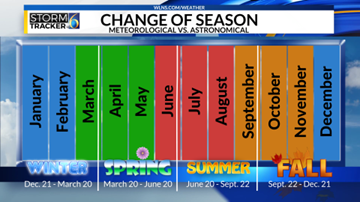LANSING, Mich. (WLNS) – Last Friday, March 1, was the first day of spring meteorologically. You might look at the date and think, “Isn't the first day of spring later in the month?”
You are not wrong. The date most people know is known as astronomical spring and usually occurs later in March.
There are two sets of seasons used by both meteorologists and climatologists. The basic way to remember this is that astronomical seasons are related to the position of the Earth and the Sun, while meteorological seasons are based on temperatures.

Starting first with the astronomical seasons. This set of seasons dates back to the equinoxes and solstices, all of which depend on the Sun's alignment over the equator and the Earth's tilt. The astronomical spring or more commonly known as the vernal equinox is when the sun's highest point is just above the equator before heading into the northern hemisphere. This year it will happen on March 19. The astronomical seasons tend to vary depending on the year. It usually ranges from 89 to 93 days depending on the year. The astronomical seasons for this year are as follows:
- Vernal Equinox: March 19, 2024
- Summer Solstice: June 20, 2024
- Autumnal Equinox: September 22, 2024
- Winter Solstice: December 21, 2024
Remember that solstices mean that there is a change between the length of day and night while equinoxes indicate a time when daylight and darkness are equal.

Now on to the meteorological seasons. Because of the varying dates and lengths during astronomical seasons, scientists have struggled to compare annual and seasonal statistics from year to year. That's why scientists decided to focus on temperatures instead. Think about this, wherever you are you usually associate cold temperatures with winter and snow. While with warm temperatures you think of summer and heat waves. Well, this same thinking is what led scientists to create meteorological seasons.

